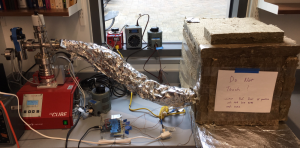One of the challenges of working with trapped ions is that collisions between the trapped ions and any other atoms can lead to scrambling of information stored in the ions’ internal states, re-ordering of ions trapped in a chain, reactions of the ions with the colliding atom, or heating and loss of ions for the trap. This is especially true for surface electrode ion traps of the sort we use in the Doret lab, as the `depth’ of the traps is much smaller than macroscopic `4-rod’ RF-Paul traps, thus collisions with background gas are significantly more likely to lead to ion loss. As a result, ion traps are typically housed in vacuum chambers and pumped down to ultra-high vacuum (UHV), with the background gas pressure in the chamber typically 10-13 that of than atmospheric pressure. Our present chamber sits at a pressure of about 10-10 Torr

New UHV chamber, insulated and under bakeout at ~340C.
In planning to implement a system to house the Sandia National Labs HOA-2.1 trap that we plan to use for our upcoming quantum simulation work we have begun construction of a new UHV chamber. In pursuit of improved vacuum, we have begun an extended high temperature (~340C) bakeout to eliminate H2 gas from the thinner-walled elements of the chamber. Such H2 is always present in steel as a consequence of the way it is manufactured. In a typical chamber the hydrogen is constantly diffusing out of the steel into the vacuum space, and is typically the dominant background gas in UHV systems. We hope to completely eliminate the H2 from upwards of 75% of the surface area of our chamber, which should significantly improve the base pressure of our new vacuum system.

